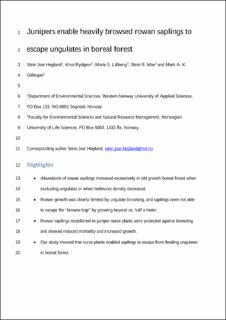| dc.contributor.author | Hegland, Stein Joar | |
| dc.contributor.author | Rydgren, Knut | |
| dc.contributor.author | Lilleeng, Marte Synnøve | |
| dc.contributor.author | Moe, Stein Ragnar | |
| dc.contributor.author | Gillespie, Mark Andrew Kusk | |
| dc.coverage.spatial | Norway, Svanøy | en_US |
| dc.date.accessioned | 2022-03-18T09:15:53Z | |
| dc.date.available | 2022-03-18T09:15:53Z | |
| dc.date.created | 2021-12-07T13:30:39Z | |
| dc.date.issued | 2021 | |
| dc.identifier.citation | Hegland, S. J., Rydgren, K., Lilleeng, M. S., Moe, S. R. & Gillespie, M. A. K. (2021). Junipers enable heavily browsed rowan saplings to escape ungulates in boreal forest. Forest Ecology and Management, 500. | en_US |
| dc.identifier.issn | 0378-1127 | |
| dc.identifier.uri | https://hdl.handle.net/11250/2986091 | |
| dc.description | This is a preprint (pre peer-review manuscript version) of an article published by Elsevier on 1 September 2021. The Version of Record is available online: https://doi.org/10.1016/j.foreco.2021.119651 | en_US |
| dc.description.abstract | Recent increases in ungulate herbivore populations have intensified browsing pressure in northern forest ecosystems. High browsing pressure affects recruitment into tree populations and saplings are among the most impacted and critical tree stages. This calls for research on factors that enhance sapling survival and promote recovery of herbivore preferred species. One understudied factor in ungulate dominated boreal forests is the ability of young trees to escape large herbivores by utilising “nurse plants”. First, we examined the impact of ungulate browsing on the abundance and size of rowan (Sorbus aucuparia), a functionally important tree species in an old-growth boreal pine forest, western Norway. The responses were compared between exclosures and ungulate-access plots over ten years (2001–2011) combined with investigations along a browsing intensity gradient (Exp. A). In a second experiment we investigated whether rowan saplings escape browsing and enhance growth and survival by growing within nurse plants. Consequently, we planted rowan saplings in ungulate browsing areas, inside and outside coniferous juniper (Juniper communis) bushes, and analysed the treatment effect on browsing, growth, and survival of rowan saplings across five years (2013–2018; Exp B). Excluding large herbivores resulted in a large increase in rowan saplings which were six times more abundant in exclosures (0.44 ind./m2) compared to ungulate-access plots (0.07 ind./m2) after ten years (Exp. A). The abundance of rowan saplings also decreased with higher browsing intensity. Moreover, the rowans in exclosures grew to almost twice the height of the ungulate-access rowans. The protected rowan saplings experienced significantly less browsing damage, and only 25% of the protected plants experienced heavy browsing or died after the first winter, compared to 70% of the unprotected plants (Exp. B). After five years, 50% more unprotected than protected plants experienced heavy browsing or mortality, and growth in protected plants was nearly 50% greater over the period. The negative impact of ungulate browsing on abundance and growth of rowans can be counteracted by positive plant-plant interactions. Rowan saplings growing within nurse plants showed significantly less browsing and better performance indicating high functional importance of the forest understorey. Forest managed with multi-layered and multi-species understoreys may therefore also be beneficial for tree recruitment in browsed boreal forest landscapes. | en_US |
| dc.language.iso | eng | en_US |
| dc.publisher | Elsevier | en_US |
| dc.title | Junipers enable heavily browsed rowan saplings to escape ungulates in boreal forest | en_US |
| dc.type | Peer reviewed | en_US |
| dc.type | Journal article | en_US |
| dc.description.version | submittedVersion | en_US |
| dc.source.pagenumber | 9 | en_US |
| dc.source.volume | 500 | en_US |
| dc.source.journal | Forest Ecology and Management | en_US |
| dc.identifier.doi | 10.1016/j.foreco.2021.119651 | |
| dc.identifier.cristin | 1965603 | |
| cristin.ispublished | true | |
| cristin.fulltext | preprint | |
| cristin.qualitycode | 2 | |
